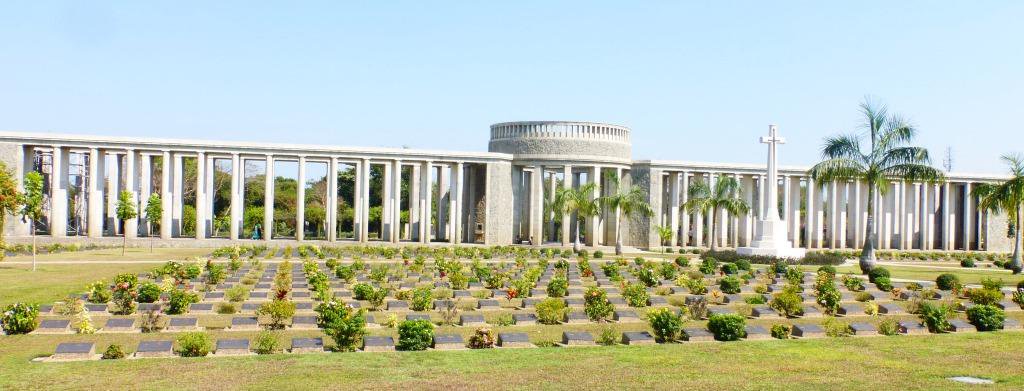12 May 2025
Commonwealth War Graves in the Second World War: A new era
With the Second World War in Europe over, the then Imperial War Graves Commission entered an exciting new phase, facing new challenges in commemoration and public engagement.
Commonwealth War Graves in the Second World War
The advance party
 Image: Major Andrew MacFarlane, leader of the Commission's "advance party"
Image: Major Andrew MacFarlane, leader of the Commission's "advance party"
The Second World War had a profound impact on the Imperial War Graves Commission (the previous incarnation of the Commonwealth War Graves Commission).
It had been hoped that a Commission memorial or cemetery would not have to be built ever again following the devastation of the First World War. Fate had other ideas when the world plunged into conflict in September 1939.
As servicemen and women fought and fell across the globe, it was obvious that the Commission was entering a new phase of activity and one of the busiest periods in its history.
On 2 August 1944, IWGC financial and post-war reconstruction advisor Sir Herbert Ellissen published a memorandum, outlining the Commission’s need to assess the ground in France and Belgium where hundreds of thousands of First World War Commission war graves dot the former Great War battlefields.
The chaos and confusion of the Nazi German invasion of France and Belgium in spring 1940 had resulted in the evacuation, expulsion, or in some cases arrest, of Commission staff working there.
Cemeteries, memorials, and war graves suffered various fates in the absence of Commission staff. Some staff were able to fly under the radar and continue their duties, while in other areas, civilians stepped in to maintain sites. Otherwise, cemeteries and memorials in the invasion and later occupied nations generally went unattended.
Commission figures had begun plotting their return before D-Day. With the military situation in Europe now favouring the Allies in the summer of 1944, senior staff discussed a return to Europe.
An “advance party” led by Major Andrew MacFarlane was formed and headed out to assess and facilitate the Commission’s return.
Regular progress reports revealed that, remarkably, most cemeteries and memorials had escaped from the fighting mostly unscathed. However, surveys did reveal some disheartening damage at key commission sites.

Image: The mighty Menin Gate was sadly damaged during the Second World War. Here we see it under repair post-war
The beautiful Menin Gate, commemorating over 50,000 missing Great War soldiers, victims of the ferocious fighting around the Ypres Salient, was significantly damaged in May 1940, for instance. Retreating British troops blew the bridge along the Menin Road to forestall the advancing Wehrmacht.

Image: Shell damage and bullet holes pepper the walls of the Villers-Bretonneux Memorial
The towered Villers-Bretonneux Memorial, dedicated to Australian troops' service and sacrifice in the First World War, saw shell and mortar damage. Its central tower, with its clear commanding views of the surrounding countryside, had been taken over by occupying forces and suffered shell damage.
Elsewhere, bullets created new unwelcome designs on the stonework at Duisans British Cemetery. A programme of post-war maintenance and reconstruction was needed.
In addition to surveying damaged sites, the advance party had other important duties, such as negotiating with civil and military authorities for the takeover of their care and maintenance on behalf of the Commission and to determine the viability of staff returning to Europe.
Post-war living conditions, marked by ration shortages, inadequate equipment, transport limitations, and housing issues made it increasingly difficult for the party to carry out their duties.

Image: Commission report on the situation in Arras, France, noting shortages of coal and other supplies
Nevertheless, by 1945, roughly ninety Commission staff had returned to France and the Head Office in Arras had officially reopened, marking the Commission’s first significant steps toward resuming its work.
The Second World War ended in Europe in May 1945, but the conflict was not over. In the Far East and the Pacific, massive fighting continued.
Following VJ Day in August 1945, the Commission’s next step was to repeat this process on a global scale as part of a much larger and more intense effort at post-war organisation than had previously been attempted after the First World War.

Want more stories like this delivered directly to your inbox? Sign up for our newsletter for regular updates on the work of Commonwealth War Graves, blogs, event news, and more.
Sign UpPost-war: a new era for the Commonwealth War Graves Commission
“After the lapse of many years, the Commission is once more going into business on a large scale…”
Sir Herbert Ellissen’s words above reflect the size of the challenge facing the Commission in a post-war world.
The Second World War had taken armies to new frontiers. It had drawn in a bewildering number of ethnicities and nationalities, each requiring appropriate commemoration, regardless of race, colour or creed.
Unlike during the First World War, the now well-established Imperial War Graves Commission was solidified in its authority. The ideals installed at the Commission’s founding and developed over nearly two decades of pre-WW2 experience informed its post-Second World War work.
Civilians and religions: fresh challenges to commemoration
One major change was the inclusion of civilian war dead in the Commission’s commemorations.
Early into the Blitz in September 1940, the bombing of major UK cities by the Luftwaffe, CWGC founder Sir Fabian Ware wrote to Prime Minister Winston Churchill to “consider the commemoration of civilians, men, women and children, by the deliberate slaughter of whom the enemy is creating a new category of normal war casualties.”
Churchill acquiesced, and so the Commission entered a new phase of work.
With Churchill’s approval, the then Imperial War Graves Commission was empowered by the government to collect and record the names of civilians who died due to enemy action in the Second World War.
Reaching out to cities, metropolitan boroughs, councils, and rural districts, as well as appealing directly to ordinary citizens, the Commission asked to submit forms advising details of those victims of hostile activity.
Additionally, a growing number of religions needed to be considered when deciding commemoration. Members practising the Hindu or Sikh faiths, for instance, are traditionally cremated, so memorials to certain Indian casualties needed to reflect this.
Commemorating a global conflict

Image: Architectural plans of Kranji War Cemetery, one of the many new Commission sites constructed after the end of the Second World War
Soldiers, sailors, and airmen had fought on seemingly every corner of the globe, from the biting winds and frigid temperatures of the arctic convoys to the dense jungle of Burma (present-day Myanmar), the craggy valleys and soaring peaks of Italy, baking tropical Pacific islands, and many more territories and environments.
This presented new challenges for the Commission. As many new sites were further afield than their Great War counterparts, difficulties arose around labour, transportation, and selection and supply of materials.
For example, the radiant white limestone headstones commonly seen in our French and Belgian sites proved ineffective for locations such as the harsh, arid deserts of North Africa or the monsoon-soaked rainforests of Thailand. New materials and grave marker designs were trialled and implemented where necessary.
New Principal Architects were brought in to design a new generation of commemorative sites, ranging from the classical style of cemeteries in Italy and Greece by Louis de Soissons to the modern influences of Colin St Clair Oakes for sites in the Far East.
These new styles and forms of remembrance demonstrate the Commission’s ability to adapt and grow with the needs of changing times, a trend that continues to this day. See the innovative design of the Cape Town Labour Corps Memorial unveiled in 2025.
Engaging with the public
 Image: One of the moving Efiles in our archive collection
Image: One of the moving Efiles in our archive collection
Sharing our work with the public has always been important, so the memories and stories of those we commemorate are kept alive forever.
Transparency is also key. Those who lost loved ones on the blood-soaked battlefields of the Second World War, beneath the waves, or high in the sky, wanted to know about where and how they were being cared for after death.
After the war, the Commission held several exhibitions aimed at informing the public on the look and feel of our Second World War-focused sites. Held in Belgium, France, and the UK, these offered a visual insight into the Commission’s future plans.
However, the main point of contact for our post-war interactions with the general public were our enquiry files (Efiles). These files, mostly letters, cover a wide range of subjects, from inquiries regarding casualty locations, personal headstone inscription requests, and everything in between.
Our Efiles are a poignant reminder of the true scale of the Second World War. Each is sent by a concerned loved one. For example, some of the letters from the public, from forlorn parents searching for any details of their missing children, are some of the most heart-breaking items in our archive.
Though the methods of engaging the public have changed over time, the Commission’s aim has stayed the same; to share with the public how we remain committed to our promise of commemoration.
Discover more of our history in the Commonwealth War Graves Commission Archive
The Commonwealth War Graves Commission’s archive tracks the history of the CWGC from our founding in 1917 to the present day.
Featuring meeting notes, blueprints, architectural designs, and much, much more, you can discover our story as it unfolded throughout the years.
The archive is available to view online with more files being regularly digitised for public availability. What will your research uncover?

